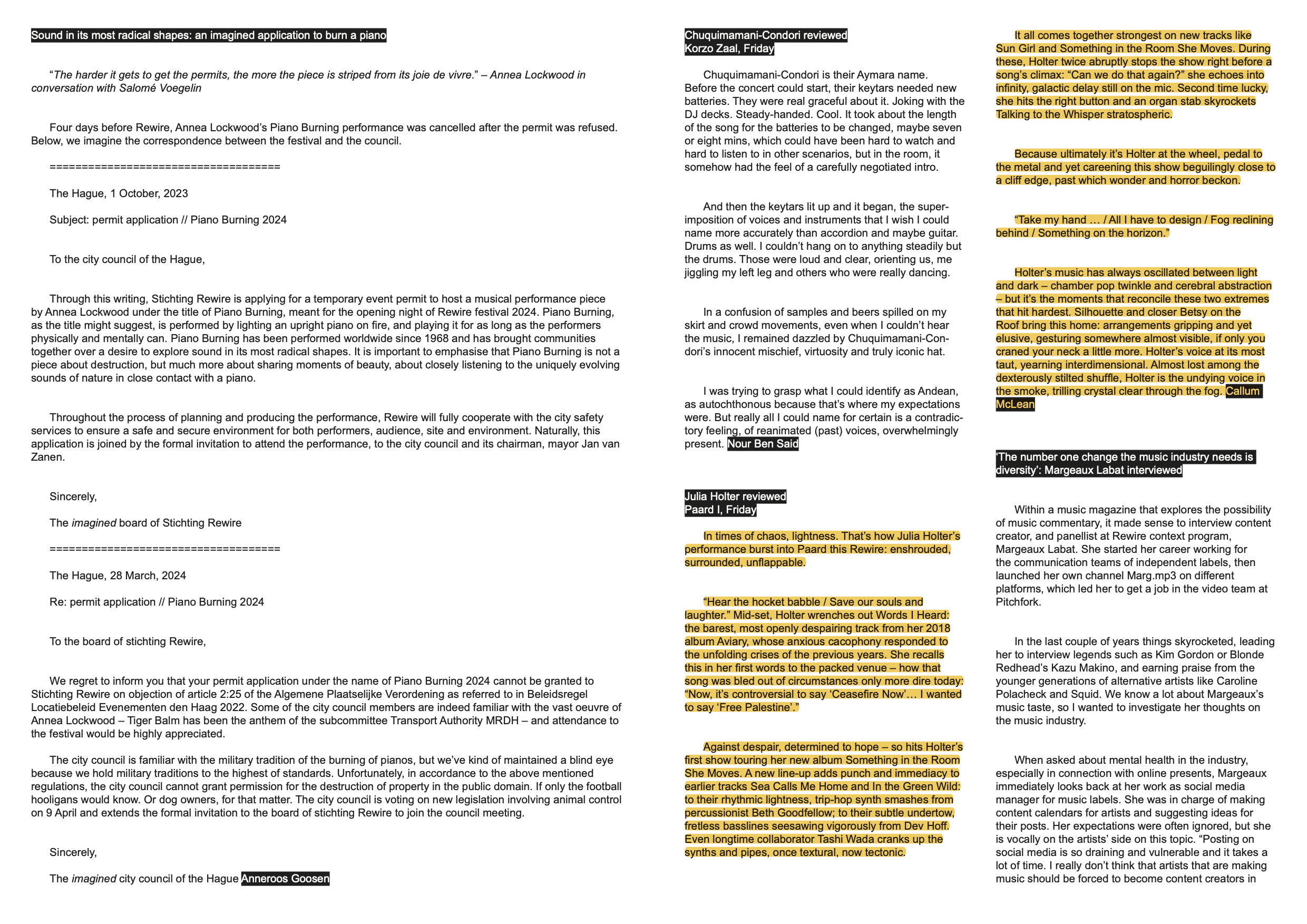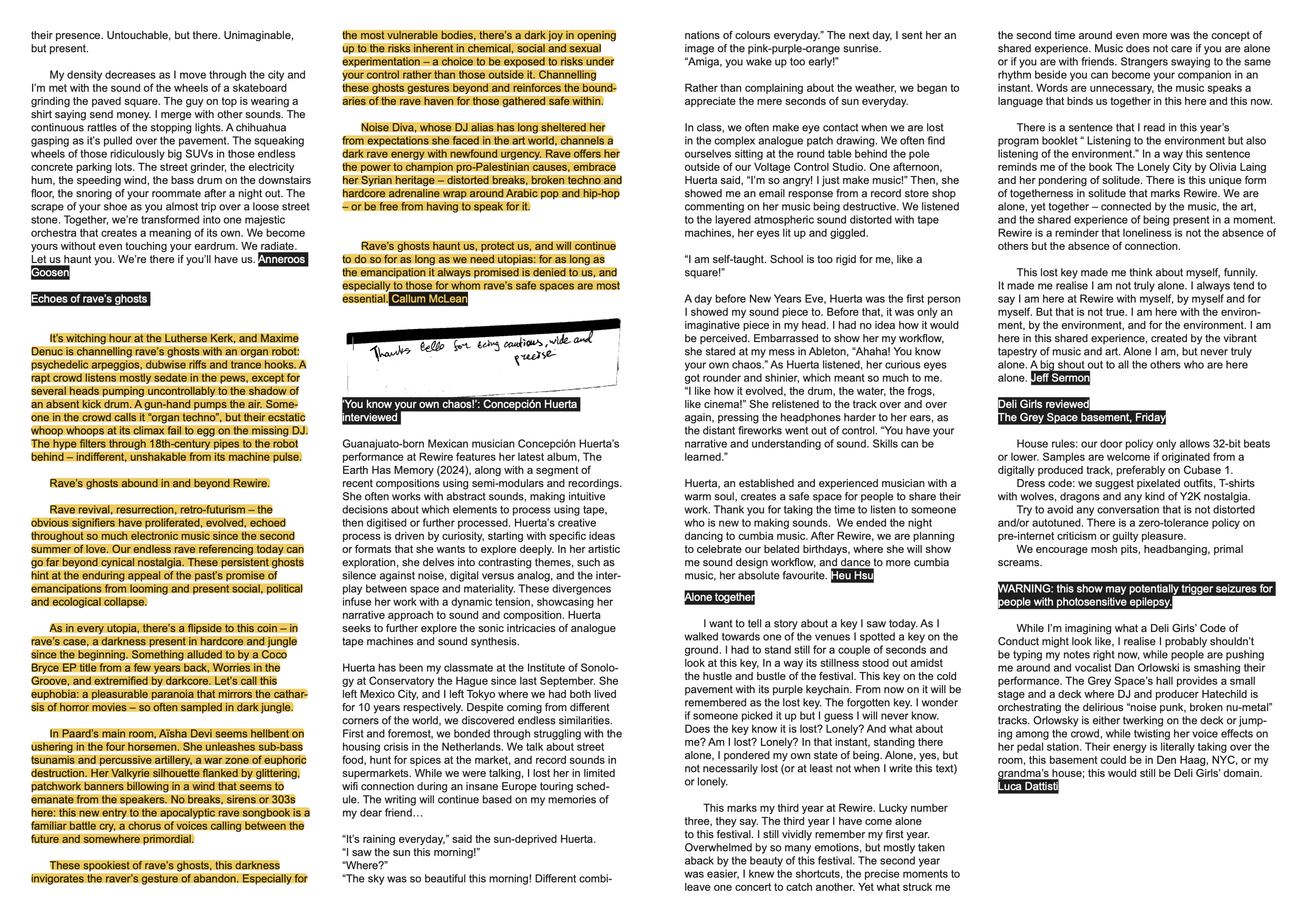Rewire Reflections
April 2024 and April 2025Zine published during Rewire 2024 & 2025
For the 2024 edition of The Hague’s music & arts festival, Rewire, I joined a group of writers publishing a zine on and during the festival. Read my three pieces below, on Julia Holter, Simo Cell and ‘echoes of rave’s ghosts’. I returned in 2025 as guest editor, alongside María Mazzanti.
Read full 2024 zine here. Online version of 2025 zine soon to be published.

[2024 articles]
Echoes of Rave’s Ghosts
It’s witching hour at the Lutherse Kerk, and Maxime Denuc is channelling rave’s ghosts with an organ robot: psychedelic arpeggios, dubwise riffs and trance hooks. A rapt crowd listens mostly sedate in the pews, except for several heads pumping uncontrollably to the shadow of an absent kick drum. A gun-hand pumps the air. Some- one in the crowd calls it “organ techno”, but their ecstatic whoop whoops at its climax fail to egg on the missing DJ. The hype filters through 18th-century pipes to the robot behind – indifferent, unshakable from its machine pulse.
Rave’s ghosts abound in and beyond Rewire.
Rave revival, resurrection, retro-futurism – the obvious signifiers have proliferated, evolved, echoed throughout so much electronic music since the second summer of love. Our endless rave referencing today can go far beyond cynical nostalgia. These persistent ghosts hint at the enduring appeal of the past’s promise of emancipations from looming and present social, political and ecological collapse.
As in every utopia, there’s a flipside to this coin – in rave’s case, a darkness present in hardcore and jungle since the beginning. Something alluded to by a Coco Bryce EP title from a few years back, Worries in the Groove, and extremified by darkcore. Let’s call this euphobia: a pleasurable paranoia that mirrors the cathar- sis of horror movies – so often sampled in dark jungle.
In Paard’s main room, Aïsha Devi seems hellbent on ushering in the four horsemen. She unleashes sub-bass tsunamis and percussive artillery, a war zone of euphoric destruction. Her Valkyrie silhouette flanked by glittering, patchwork banners billowing in a wind that seems to emanate from the speakers. No breaks, sirens or 303s here: this new entry to the apocalyptic rave songbook is a familiar battle cry, a chorus of voices calling between the future and somewhere primordial.
These spookiest of rave’s ghosts, this darkness invigorates the raver’s gesture of abandon. Especially for
the most vulnerable bodies, there’s a dark joy in opening up to the risks inherent in chemical, social and sexual experimentation – a choice to be exposed to risks under your control rather than those outside it. Channelling these ghosts gestures beyond and reinforces the bound- aries of the rave haven for those gathered safe within.
Noise Diva, whose DJ alias has long sheltered her from expectations she faced in the art world, channels a dark rave energy with newfound urgency. Rave offers her the power to champion pro-Palestinian causes, embrace her Syrian heritage – distorted breaks, broken techno and hardcore adrenaline wrap around Arabic pop and hip-hop – or be free from having to speak for it.
Rave’s ghosts haunt us, protect us, and will continue to do so for as long as we need utopias: for as long as the emancipation it always promised is denied to us, and especially to those for whom rave’s safe spaces are most essential.
Julia Holter reviewed Paard I, Friday
In times of chaos, lightness. That’s how Julia Holter’s performance burst into Paard this Rewire: enshrouded, surrounded, unflappable.
“Hear the hocket babble / Save our souls and laughter.” Mid-set, Holter wrenches out Words I Heard: the barest, most openly despairing track from her 2018 album Aviary, whose anxious cacophony responded to the unfolding crises of the previous years. She recalls this in her first words to the packed venue – how that song was bled out of circumstances only more dire today: “Now, it’s controversial to say ‘Ceasefire Now’... I wanted to say ‘Free Palestine’.”
Against despair, determined to hope – so hits Holter’s first show touring her new album Something in the Room She Moves. A new line-up adds punch and immediacy to earlier tracks Sea Calls Me Home and In the Green Wild: to their rhythmic lightness, trip-hop synth smashes from percussionist Beth Goodfellow; to their subtle undertow, fretless basslines seesawing vigorously from Dev Hoff. Even longtime collaborator Tashi Wada cranks up the synths and pipes, once textural, now tectonic.
It all comes together strongest on new tracks like Sun Girl and Something in the Room She Moves. During these, Holter twice abruptly stops the show right before a song’s climax: “Can we do that again?” she echoes into infinity, galactic delay still on the mic. Second time lucky, she hits the right button and an organ stab skyrockets Talking to the Whisper stratospheric.
Because ultimately it’s Holter at the wheel, pedal to the metal and yet careening this show beguilingly close to a cliff edge, past which wonder and horror beckon.
“Take my hand ... / All I have to design / Fog reclining behind / Something on the horizon.”
Holter’s music has always oscillated between light and dark – chamber pop twinkle and cerebral abstraction – but it’s the moments that reconcile these two extremes that hit hardest. Silhouette and closer Betsy on the Roof bring this home: arrangements gripping and yet elusive, gesturing somewhere almost visible, if only you craned your neck a little more. Holter’s voice at its most taut, yearning interdimensional. Almost lost among the dexterously stilted shuffle, Holter is the undying voice in the smoke, trilling crystal clear through the fog.
Creating imaginary worlds is simply the very essence of our humanity’: Simo Cell interviewed
Over the years, Nantes-born Simo Cell has become a reliable source of club bangers: explosive, futuristic floor-shakers with strong roots in Bristol and UK sounds, dub and hardcore. In 2023, his first full-length Cuspide des Sirènes took these and a wider palette of sounds and created an immersive, cinematic journey, borrowing heav- ily from the fantastical video games of his childhood. This was not the first time rave and UK styles had intermingled with video games: see the jungle soundtracks of the 90s, or grime’s heavy borrowing from fourth and fifth-gen console sounds. But Simo Cell took rave-game synergy to new levels, each track corresponding to a level in this expansively realised quest towards a magical lake called Grand-Lieu. There’s even a Gameboy cartridge, where this world is rendered in 8-bit retro glory.
This nexus shouldn’t be surprising: electronic music and video games both have peculiarly generative, animative power. Power to generate movement, and to animate new realities. In his own words, Simo Cell introduces us to his own recipe for bass world-building.
“I am fascinated by the impermanent nature of our being and the ever-changing, ever-recomposing world. This is what I try to capture when I go to the studio and switch on my machines. A meeting, a phrase, a smell.
“The conception of the album lasted three years, and during this period, I had an obsession with butterflies through reading Emmanuelle Coccia’s work Métamor- phoses. The insect that crawls, transforming into a flying being, feeding on light. There’s an almost chimerical aspect to it.
“Hence the Sirens [of Cuspide des Sirènes]. As I was writing, there were many voices reminiscent of the Sirens’ songs, notably because I worked with AI software called Vocaloid. This fantastical aesthetic accompanied me during the composition of the album. And naturally, I began to imagine the possibility of creating a world around the album over time.
“Spending three years on a record leads to introspection, and I drew on my childhood memories to imagine a story inspired by Zelda: the side quests, the psychology of the characters, the psychedelic witches, the Zora fountain.
“Since my childhood, I’ve been told all sorts of legends about the lake that borders the village of my grandpar- ents, where I composed part of the album: a village engulfed by the waters, a mad horse that roamed around the lake searching for walkers to kill... The legend of Grand-Lieu began to take shape in my mind.
“Creating imaginary worlds [whether in video games or music making] is simply the very essence of our human- ity. Everything around us in our human lives was first imagined in a human brain, from the roads to the chairs to our clothes... Literally everything that frames our lives is the product of our imagination. We live in Minecraft, if you think about it for two minutes. Humans are beings of imagination.
“Similarly, when I go to play [music], I see myself as a creator of movement. I think it’s universal, it’s central. It’s just the form that changes a little. Today, it manifests through the sound system: [It’s] about the bass. Infrabass can’t be heard, but it shakes you. It’s these super low waves, something akin to the earth moving. It’s really organic, in a way.
“But for me, the rave – the act of coming together to dance and share a moment of collective frenzy – has also always been there.”


